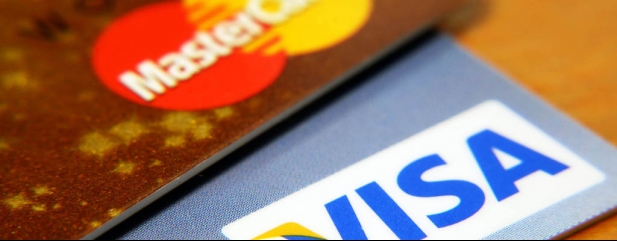Archived article
Please note that tax, investment, pension and ISA rules can change and the information and any views contained in this article may now be inaccurate.
Visa versus Mastercard: which could make you the most money

Buy something in-store or online these days and it’s a fair bet you’ll use a credit or debit card powered by Visa (V:NYSE) or Mastercard (MC:NYSE). The use of digital wallets (PayPal, Google Pay, Apple Pay etc) may be growing rapidly, but Visa and Mastercard remain the giants in the electronic payments pool, dominating transactions globally.
Between them, the duopoly processes about 340 billion annual transactions with a value of around $18 trillion. Both S&P 500 constituents, these are mature, stable companies at the sharp end of the hugely profitable payment processing business.
Both Visa and Mastercard trade on relatively high valuations, but they’re expected to continue to post brisk earnings growth. So which of these two stocks should you have in your ISA or SIPP? Should you own both, or neither?
We believe investors should have exposure to both Visa and Mastercard in a well-balanced portfolio. This means that you will gain exposure to whichever performs better over time, while still hopefully getting reliably better than the market returns from the other.
We lean slightly towards the greater scale of Visa, but that is a marginal call.
HOW DO THEY DIFFER
Given the relative parity that exists among the pair, you might be forgiven for thinking that any differences separating the businesses would be paper thin. The pair match up closely on many major barometers of success. For instance, both companies are growing their annual revenue at around 25% apiece, while the gross profit margin runs at close to 100% for both, giving them plenty of control over their own costs, an important factor in an inflationary environment.
In this year’s helter-skelter stock market, both share prices have held up reasonably well, Mastercard drifting around 3.5% lower since the end of December 2021; Visa down about 4.2%. For comparison, the S&P 500 has lost nearly 14% this year.
Both companies have been exceptional wealth creators for investors over the years. According to Morningstar data, Mastercard and Visa have produced annualised total returns (share price plus dividend income) of 24.6% and 22.6% respectively, over the past decade.
That difference might look marginal at first glance, but the power of compounding makes a big difference. For every £1,000 invested, Mastercard investors would today have £9,041.20 versus £7,640.70 for Visa investors.
However, to suggest that the two companies are merely financial doppelgangers of one another would be to misrepresent reality.
To put their market caps into perspective, Visa is the 11th-largest company in the S&P 500 index, while Mastercard is 16th.
Let’s take a closer look at the investment metrics that might help us form a conclusion about both stocks.
REVENUE GROWTH AND PROFITS
Here’s a comparison of numbers for the first quarter versus the previous year.
Visa’s operating margins (earnings before interest and tax divided by net revenue) were better for both periods. But while Visa is currently more profitable than Mastercard, the earnings growth of Mastercard is almost twice as high, 58.6% to 29.7%.
Visa and MasterCard each have high ROE, or return on equity ratios. Visa’s ROE of 40% is considered very good, but Mastercard truly excels with a ROE of 142%.
Another way to measure operating performance is ROIC, or return on invested capital, which is operating profit after tax divided by the sum of debt and equity. For Visa, the ROIC over the past 12 months was 21.1%, according to Investing,com data, compared to a five-year average of 17.3%.
Mastercard recorded 39.3% ROIC over the past year versus its rough 41% five-year average, so substantially higher on both counts, suggesting it has been getting much greater bang for its buck when it spends money.
Mastercard is the smaller of the two entities and so should have greater room to grow in the industry, which it seems to be doing.
EARNINGS ESTIMATES
There is certainly promising past data for both companies, but the market is forward looking and investors want to know if these growth and return metrics are sustainable into the future. Overleaf are consensus EPS (earnings per share) estimates drawn from analysts polled by Koyfin for the current year and following 12 months – that’s to 30 September for Visa and the 31 December for Mastercard – plus implied growth.
Those estimates imply that Mastercard will continue to grow earnings more than Visa in the near future. In both cases, however, it underlines the point that Visa and Mastercard trade on relatively high valuations when compared to the S&P 500.
Here we can see that Mastercard’s faster growth is reflected by its higher PE compared to Visa, but that both trade at premiums to the S&P 500. Yet that is no reason not to own Visa or Mastercard since both tend to trade on valuations above the market average because of their dominant industry positions and long track record of superior investment returns.
The five and 10-year return figures show that the longer investors hold shares in Visa and Mastercard, the greater the likelihood of outperformance versus the market.
LOOKING TO THE FUTURE
Mastercard has positioned itself as a data leader with its Mastercard Spending Pulse reports, and it has expanded into the cryptocurrency space through its Mastercard Start Path Crypto program, focused on start-up companies using blockchain technology. It also recently bought CipherTrace, a cryptocurrency intelligence company offering digital asset security and fraud solutions to banks, exchanges and other financial institutions.
Other recent acquisitions include personalisation platform and decision engine Dynamic Yield, Latin American real-time payments application firm Arcus Fi, and Aiia, a European open banking technology provider that offers single access and secure API (application programming interface) access to banks and financial institutions.
Not unlike Mastercard, Visa also presents itself as a financial data champion through its US Spending Momentum Index. It is also moving deeper into the cryptos space, and in December 2021 launched its Global Crypto Advisory Practice, designed to help clients on their own crypto journeys.
Visa’s own acquisitions were limited to the purchase of Currencycloud, a London-based platform that enables banks and fintechs to provide foreign exchange solutions for cross-border payments, and Tink. It is another open banking platform that enables financial institutions, fintechs and merchants to build tailored financial management tools, products and services for European consumers and businesses based on their financial data.
Both companies are dominant players in the credit and debit card industry, are expanding into new growth areas and offer reliable returns in the long run. Comparatively, innovation and future growth measures will dictate which company does better, relative to the other, but both look strongly placed to outperform the wider market for years to come.
Important information:
These articles are provided by Shares magazine which is published by AJ Bell Media, a part of AJ Bell. Shares is not written by AJ Bell.
Shares is provided for your general information and use and is not a personal recommendation to invest. It is not intended to be relied upon by you in making or not making any investment decisions. The investments referred to in these articles will not be suitable for all investors. If in doubt please seek appropriate independent financial advice.
Investors acting on the information in these articles do so at their own risk and AJ Bell Media and its staff do not accept liability for losses suffered by investors as a result of their investment decisions.
Issue contents
Editor's View
Feature
Great Ideas
Investment Trusts
News
- Tesla and Microsoft give investors fresh reasons to fret
- Why boot brand Dr. Martens is walking tall by delivering growth
- Why the timing of Sandberg’s exit from Meta is terrible given severe challenges
- What the latest FTSE reshuffle means for the UK's leading shares
- Is it finally time to take a proper look at the Chinese market?

 magazine
magazine








